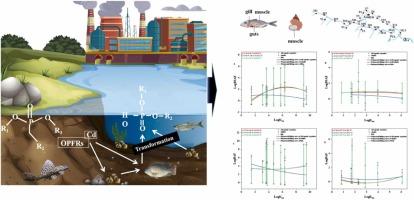Bioaccumulation and tissue distribution of Cadmium, Organophosphate Flame Retardants and their Di-alkyl phosphates transformation products in a South China river
IF 11.3
1区 环境科学与生态学
Q1 ENGINEERING, ENVIRONMENTAL
引用次数: 0
Abstract
The co-existence of organophosphate flame retardants (OPFRs) and cadmium (Cd) in aquatic ecosystems raises concerns about their bioaccumulation dynamics. This study investigated the Lianjiang River Basin to elucidate the spatiotemporal distribution, tissue-specific accumulation, and interactions of Cd, OPFRs and their di-alkyl phosphate (DAPs) metabolites. Detection results indicated that surface waters contained Σ12OPFRs at 1.0–9.1×104 ng/L, Σ7DAPs at n.d.–1.41×103 ng/L, and Cd at 1.88–40×103 ng/L. Sediments exhibited higher levels, with Σ12OPFRs of 2.35–269×105 ng/g dry weight (dw), Σ7DAPs of 1.83–3.43×104 ng/g dw, and Cd of 4.48×10−2–1.28 ng/g dw. Tissue-specific patterns showed fish guts accumulated the highest ∑12OPFRs (2.48×103 ng/g lipid weight, lw) and Cd (0.641 ng/g dw), whereas DAPs concentrated in muscle (1.37×103 ng/g lw). Hydrophobic OPFRs exhibited higher bioaccumulation in whelks (logBAF=4.21) than in fish (logBAF=3.98–4.04), with DAP accumulation linked to species-specific metabolism. A high metabolite-parent ratio (MPCF=8.88 for DPHP/TPHP) highlighted spatial variation in biotransformation. Complex interactions were observed: Cd synergized with OPFRs in fish guts (p < 0.001) but antagonized DAPs in whelks (p < 0.05). Downstream hotspots correlated with industrial emissions. This study provides the first evidence of tissue- and species-specific co-accumulation, urging integration of transformation products and multi-pollutant interactions into ecological risk assessments for contaminated aquatic systems.Environmental Implication
This study reveals combined pollution of Cd, OPFRs, and DAPs in the Lianjiang River. The findings include tissue/species-specific accumulation (OPFRs/Cd in fish guts, DAPs in muscle), higher hydrophobic OPFRs bioaccumulation in whelks, and species-dependent Cd-OPFR interactions (synergy in fish, antagonism in whelks). DAPs concentrations match parent OPFRs, with Cd enhancing contaminant correlations. These challenge single-pollutant assessments and urge integrating transformation products and multi-pollutant dynamics into risk frameworks, especially in industrial basins like Guiyu, for targeted monitoring and holistic management.

华南某河流镉、有机磷阻燃剂及其转化产物的生物积累和组织分布
有机磷酸盐阻燃剂(OPFRs)和镉(Cd)在水生生态系统中的共存引起了人们对其生物蓄积动力学的关注。本研究以连江流域为研究对象,探讨Cd、OPFRs及其代谢产物DAPs的时空分布、组织特异性积累及其相互作用。检测结果表明,地表水中含有Σ12OPFRs (1.0-9.1×104 ng/L)、Σ7DAPs (n.d.-1.41×103 ng/L)和Cd (1.88-40×103 ng/L)。沉积物中Cd含量较高,Σ12OPFRs为2.35-269×105 ng/g干重(dw), Σ7DAPs为1.83-3.43×104 ng/g dw, 4.48×10−2 ~ 1.28 ng/g dw。组织特异性模式显示,鱼内脏累积的∑12OPFRs (2.48×103 ng/g脂质重量,lw)和Cd (0.641 ng/g dw)最高,而DAPs集中在肌肉(1.37×103 ng/g lw)。疏水性opfr在海螺中的生物积累(logBAF=4.21)高于在鱼类中的生物积累(logBAF= 3.98-4.04), DAP的积累与物种特异性代谢有关。高代谢物-亲本比(DPHP/TPHP的MPCF=8.88)突出了生物转化的空间差异。观察到复杂的相互作用:Cd在鱼内脏中与OPFRs协同作用(p < 0.001),但在海螺中拮抗DAPs (p < 0.05)。下游热点与工业排放相关。该研究提供了组织和物种特异性共同积累的第一个证据,敦促将转化产物和多污染物相互作用整合到受污染水生系统的生态风险评估中。本研究揭示了连江流域Cd、OPFRs和DAPs的复合污染。研究结果包括组织/物种特异性积累(鱼类肠道中的OPFRs/Cd,肌肉中的DAPs),海螺中较高的疏水性OPFRs生物积累,以及物种依赖性Cd- opfr相互作用(鱼类的协同作用,海螺的拮抗作用)。DAPs浓度与母体OPFRs相匹配,Cd增强了污染物的相关性。这对单一污染物评估提出了挑战,并敦促将转型产品和多污染物动态纳入风险框架,特别是在贵屿这样的工业流域,以便进行有针对性的监测和整体管理。
本文章由计算机程序翻译,如有差异,请以英文原文为准。
求助全文
约1分钟内获得全文
求助全文
来源期刊

Journal of Hazardous Materials
工程技术-工程:环境
CiteScore
25.40
自引率
5.90%
发文量
3059
审稿时长
58 days
期刊介绍:
The Journal of Hazardous Materials serves as a global platform for promoting cutting-edge research in the field of Environmental Science and Engineering. Our publication features a wide range of articles, including full-length research papers, review articles, and perspectives, with the aim of enhancing our understanding of the dangers and risks associated with various materials concerning public health and the environment. It is important to note that the term "environmental contaminants" refers specifically to substances that pose hazardous effects through contamination, while excluding those that do not have such impacts on the environment or human health. Moreover, we emphasize the distinction between wastes and hazardous materials in order to provide further clarity on the scope of the journal. We have a keen interest in exploring specific compounds and microbial agents that have adverse effects on the environment.
 求助内容:
求助内容: 应助结果提醒方式:
应助结果提醒方式:


